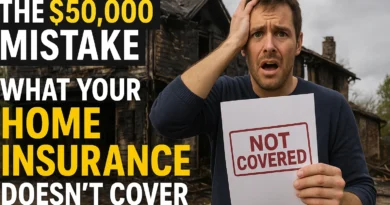Minimum Coverage vs Full Coverage: What Insurance Companies Don’t Tell You
When Marcus bought his first car, the insurance agent gave him two options: minimum coverage for $89 per month, or full coverage for $167 per month. The choice seemed obvious—he was young, broke, and needed to keep his expenses low. He chose minimum coverage and saved nearly $1,000 that first year.
Three months later, Marcus rear-ended an SUV at a red light. The damage seemed minor—a few scratches and a small dent. But what started as a simple fender-bender turned into a financial catastrophe that haunts him to this day. The “minor” accident cost him over $18,000 out of pocket, forced him to declare bankruptcy, and destroyed his credit for seven years.
Marcus learned the hard way what insurance companies rarely explain clearly: the difference between minimum coverage and full coverage isn’t just about monthly payments—it’s about financial survival. The industry makes billions of dollars from customers who don’t understand this critical distinction, and they’re perfectly happy to keep you in the dark.
Today, we’re going to expose the truths about minimum vs. full coverage that insurance companies hope you’ll never discover. By the end of this article, you’ll understand exactly what each type of coverage does and doesn’t protect, how much financial risk you’re really taking with minimum coverage, and how to make an informed decision that could save you from financial ruin.
The $47 Billion Secret: Why Insurance Companies Love Minimum Coverage Customers
Here’s what insurance companies don’t want you to know: they make significantly higher profit margins on minimum coverage policies. While full coverage customers cost insurance companies more in potential claims, minimum coverage customers generate nearly pure profit because the coverage limits are so low that the insurance company rarely pays out large claims.
Industry data reveals that minimum coverage policies have loss ratios (the percentage of premiums paid out in claims) of just 35-45%, compared to 65-75% for full coverage policies. This means insurance companies keep 55-65% of minimum coverage premiums as profit, compared to 25-35% for full coverage policies.
The math is staggering: minimum coverage customers generate over $47 billion in excess profits for insurance companies annually. These customers pay premiums for coverage that provides minimal actual protection, essentially subsidizing the industry while remaining financially vulnerable.
What “Minimum Coverage” Really Means (And Why It’s Not Enough)
Minimum coverage refers to the lowest amount of auto insurance your state requires you to carry. But here’s the first thing insurance companies don’t tell you: these minimums were set decades ago and have never been adjusted for inflation, modern vehicle costs, or current medical expenses.
The Shocking Reality of State Minimums
Let’s look at what minimum coverage actually provides in several states:
Florida Minimum Requirements:
- $10,000 Personal Injury Protection (PIP)
- $10,000 Property Damage Liability
- No Bodily Injury Liability required
- Total minimum coverage: $20,000
California Minimum Requirements:
- $15,000 Bodily Injury Liability per person
- $30,000 Bodily Injury Liability per accident
- $5,000 Property Damage Liability
- Total minimum coverage: $50,000
Texas Minimum Requirements:
- $30,000 Bodily Injury Liability per person
- $60,000 Bodily Injury Liability per accident
- $25,000 Property Damage Liability
- Total minimum coverage: $115,000
Now, here’s why these amounts are woefully inadequate:
- The average new car costs $48,000+
- The average emergency room visit costs $2,200
- The average ambulance ride costs $1,200
- A typical orthopedic surgery costs $35,000-$75,000
- Lost wages for a serious injury can exceed $100,000 annually
In Marcus’s case, the person he hit suffered a herniated disc that required surgery. The medical bills alone totaled $67,000, but his minimum coverage only provided $30,000 in bodily injury protection. He was personally liable for the remaining $37,000, plus legal fees, plus the property damage that exceeded his property damage limits.
What Minimum Coverage Doesn’t Include
Here’s what insurance companies often fail to clearly explain about minimum coverage:
No Comprehensive Coverage: Minimum policies don’t cover theft, vandalism, weather damage, or animal collisions. If your car is stolen or destroyed by hail, you get nothing.
No Collision Coverage: If you cause an accident, minimum coverage won’t pay to repair or replace your own vehicle. You could be left without a car and still owe money on your auto loan.
No Uninsured Motorist Coverage: In most states, minimum policies don’t include protection against uninsured drivers. With one in eight drivers being uninsured, this is a massive gap.
No Medical Payments Coverage: Beyond the minimal PIP requirements in some states, minimum policies typically don’t cover your medical expenses from an accident.
No Rental Car Coverage: You’ll pay out of pocket for rental cars while your vehicle is being repaired or replaced.
No Gap Coverage: If you owe more on your car loan than the car is worth, minimum coverage won’t bridge that gap.
The True Cost of “Cheap” Insurance: Real-World Examples
Insurance companies market minimum coverage as affordable protection, but the reality is that it’s expensive false security. Here are real examples of how minimum coverage fails:
Case Study 1: The $85,000 Fender Bender
Jennifer had minimum coverage when she accidentally hit a luxury SUV in a parking lot. The damage looked minor—a small dent and scratched paint. But the repair estimate came to $8,500 due to specialized paint and sensors in the bumper. Her property damage coverage was limited to $5,000, leaving her with a $3,500 bill.
But that wasn’t the end. The other driver complained of neck pain and went to the emergency room. What started as precautionary medical care turned into months of physical therapy and diagnostic tests. The final medical bills totaled $23,000. Jennifer’s bodily injury coverage was $15,000 per person, leaving her personally liable for $8,000 in medical expenses.
Total out-of-pocket cost: $11,500 for what appeared to be a minor accident.
Case Study 2: The Uninsured Driver Nightmare
Mike was hit by an uninsured driver who ran a red light. The accident totaled Mike’s car (worth $15,000) and sent him to the hospital with a broken arm and concussion. His minimum coverage policy didn’t include uninsured motorist protection.
Result: Mike received nothing from his insurance company. He had to pay for his own medical treatment ($22,000), replace his own car ($15,000), and cover his lost wages during recovery ($8,000). Total cost: $45,000.
If Mike had carried full coverage with uninsured motorist protection, his insurance would have covered virtually all of these costs.
Case Study 3: The Total Loss Reality Check
Sarah’s car was stolen from her driveway. The vehicle was worth $18,000, and she still owed $21,000 on her auto loan. Her minimum coverage policy included no comprehensive coverage and no gap coverage.
Insurance payout: $0. Sarah still had to pay off the remaining $21,000 loan on a car she no longer had, plus come up with money for a replacement vehicle.
What “Full Coverage” Really Includes (And Why Insurance Companies Downplay It)
When insurance agents mention “full coverage,” they’re typically referring to a policy that includes liability coverage plus comprehensive and collision coverage. But even this definition varies significantly between companies and agents.
Standard Full Coverage Components
Liability Coverage (Higher Limits):
- Bodily Injury Liability: $100,000+ per person, $300,000+ per accident
- Property Damage Liability: $50,000+ per accident
Comprehensive Coverage:
- Theft, vandalism, weather damage, animal collisions
- Usually includes glass coverage
- Typically has a $500-$1,000 deductible
Collision Coverage:
- Covers damage to your vehicle in accidents
- Includes single-car accidents and collisions with objects
- Usually has a $500-$1,000 deductible
Uninsured/Underinsured Motorist Coverage:
- Protects you when other drivers have no insurance or insufficient coverage
- Often mirrors your liability limits
Optional but Important Additional Coverages
Medical Payments/Personal Injury Protection:
- Covers medical expenses regardless of fault
- Can include lost wages and essential services
Rental Car Coverage:
- Pays for rental cars during repairs
- Typically $30-$50 per day with maximum limits
Gap Coverage:
- Covers the difference between what you owe and what the car is worth
- Essential for new cars and long-term loans
Roadside Assistance:
- Towing, jump-starts, lockout service
- Often cheaper than AAA membership
The Math Insurance Companies Don’t Want You to See
Here’s a side-by-side comparison of minimum vs. full coverage costs over a typical 6-year ownership period:
Minimum Coverage Scenario
- Monthly Premium: $89
- Annual Premium: $1,068
- 6-Year Premium Total: $6,408
- Estimated Out-of-Pocket Claim Costs: $8,500
- Total Cost: $14,908
Full Coverage Scenario
- Monthly Premium: $167
- Annual Premium: $2,004
- 6-Year Premium Total: $12,024
- Estimated Out-of-Pocket Claim Costs: $1,200
- Total Cost: $13,224
In this example, full coverage actually costs $1,684 LESS over six years when you factor in the typical out-of-pocket expenses that minimum coverage doesn’t protect against.
The Insurance Company Profit Motive: Why They Push Minimum Coverage
Insurance companies have financial incentives to sell minimum coverage that they rarely disclose:
Higher Profit Margins
Minimum coverage policies generate profit margins of 55-65% compared to 25-35% for full coverage policies. Companies make more money when customers choose less protection.
Lower Claims Exposure
With minimum coverage, the insurance company’s maximum exposure is limited to very low amounts. They’re essentially collecting premiums while accepting minimal risk.
Customer Retention Through Pricing
Customers who choose minimum coverage based on price are less likely to shop around, giving companies stable revenue streams from profitable policies.
Cross-Selling Opportunities
Companies can later sell additional coverage to minimum coverage customers, often at higher rates than if they had purchased full coverage initially.
READ ALSO: Why Your Auto Insurance Just Went Up (And How to Fight Back)
What Insurance Agents Don’t Tell You About Coverage Decisions
Many insurance agents have sales incentives that don’t align with your best interests:
Commission Structures
Some agents earn higher commissions on certain types of policies, which may influence their recommendations.
Sales Quotas
Agents may be pressured to sell a certain number of policies per month, leading to emphasis on closing sales rather than ensuring adequate coverage.
Company Policies
Some insurance companies instruct agents to present minimum coverage as the default option and only mention additional coverage if the customer asks.
Complexity Avoidance
It’s easier and faster to sell simple minimum coverage than to explain the benefits and necessity of comprehensive protection.
Hidden Risks of Minimum Coverage That Companies Minimize
Beyond the obvious coverage gaps, minimum coverage carries hidden risks that insurance companies rarely discuss:
Legal Liability Exposure
If you cause an accident that exceeds your coverage limits, you can be sued personally for the difference. This can result in wage garnishment, asset seizure, and liens on your property.
Credit Score Impact
Being unable to pay accident-related expenses can force you to use credit cards or skip payments, damaging your credit score and affecting your ability to get loans, rent apartments, or even get certain jobs.
Bankruptcy Risk
Serious accidents with minimum coverage can result in debts large enough to force bankruptcy, affecting your financial life for years.
Employment Consequences
Some employers run credit checks or consider financial stability when making hiring decisions. Accident-related financial problems could affect your career.
Family Financial Impact
Inadequate insurance doesn’t just affect you—it can impact your family’s financial stability, your children’s college funds, and your retirement planning.
The Geographic Risk Factor Insurance Companies Rarely Explain
Your location significantly affects the adequacy of minimum coverage, but insurance companies rarely explain this clearly:
High-Cost Areas
In expensive metropolitan areas, minimum coverage limits are particularly inadequate:
- Higher medical costs
- More expensive vehicles on the road
- Higher repair costs
- More aggressive legal environment for accident claims
Tourist Areas
Areas with tourist traffic often see more expensive rental cars and out-of-state drivers with different coverage expectations, increasing your potential liability exposure.
Weather-Prone Regions
Areas with severe weather make comprehensive coverage especially valuable, but this isn’t always emphasized when selling minimum coverage.
High-Crime Areas
Vehicle theft and vandalism rates vary significantly by location, making comprehensive coverage more or less critical depending on where you live.
Industry Tricks That Keep You Underinsured
Insurance companies use several tactics to keep customers with inadequate minimum coverage:
Anchoring on Price
By leading with the monthly payment amount rather than explaining coverage details, companies anchor customers on price rather than protection value.
Complexity Overwhelm
Insurance terminology is deliberately complex, making it difficult for customers to understand what they’re buying and what they’re missing.
False Security Language
Terms like “basic protection” and “essential coverage” make minimum policies sound adequate when they’re actually insufficient.
Delayed Disclosure
Important coverage limitations are often buried in policy documents that customers don’t receive until after purchase.
Renewal Inertia
Companies count on customers not reviewing their coverage annually, allowing them to keep inadequate policies indefinitely.
How to Determine What Coverage You Actually Need
Instead of choosing based on state minimums or insurance company recommendations, use this systematic approach:
Step 1: Calculate Your Asset Exposure
Add up your assets that could be at risk in a lawsuit:
- Home equity
- Savings and investments
- Current and future income
- Retirement accounts (in some states)
Your liability coverage should protect these assets, typically requiring limits of $250,000-$500,000 or more.
READ ALSO: 7 Hidden Fees Your Auto Insurance Company Hopes You’ll Never Notice
Step 2: Evaluate Your Vehicle’s Value and Loan Status
If your car is worth more than $4,000 or you have a loan, you need comprehensive and collision coverage. Consider:
- Current market value
- Outstanding loan amount
- Your ability to replace the vehicle without insurance coverage
Step 3: Assess Your Medical Insurance
While health insurance covers medical expenses, it doesn’t cover lost wages, and you might face higher deductibles or co-pays. Medical payments coverage can bridge these gaps.
Step 4: Consider Your Risk Tolerance
Ask yourself: “Can I afford to pay $20,000-$50,000 out of pocket if I cause an accident?” If the answer is no, you need more than minimum coverage.
Step 5: Factor in Your Location’s Risks
Consider local factors:
- Uninsured driver rates in your area
- Common vehicle values
- Weather risks
- Crime rates
- Medical costs
The Smart Way to Balance Cost and Coverage
You don’t have to choose between adequate protection and affordable premiums. Here’s how to optimize both:
Increase Deductibles Strategically
Higher deductibles can significantly reduce premiums while maintaining coverage. Consider:
- $1,000 collision deductible instead of $500
- $500 comprehensive deductible for most situations
- Ensure you can afford the higher deductibles in an emergency
Optimize Liability Limits
Don’t just accept standard packages. Consider:
- $250,000/$500,000/$100,000 as a reasonable middle ground
- Higher limits are often surprisingly affordable
- Umbrella policies for additional liability protection
Bundle Strategically
Combining auto and home/renters insurance often reduces costs while improving coverage.
Shop Multiple Companies
Coverage costs vary dramatically between insurers. Get quotes from:
- National carriers
- Regional companies
- Direct-to-consumer insurers
- Insurance through credit unions or employers
Red Flags That You’re Underinsured
Watch for these warning signs that your coverage is inadequate:
Policy Red Flags
- Your liability limits equal your state’s minimums
- You have no comprehensive or collision coverage on a financed vehicle
- Your coverage hasn’t been reviewed in 3+ years
- You chose your policy based solely on price
Financial Red Flags
- You couldn’t afford a $10,000-$25,000 unexpected expense
- You have significant assets but low liability limits
- You drive in high-risk areas with minimal coverage
- Your coverage limits haven’t increased with inflation
Life Change Red Flags
- You’ve moved to a different area
- Your income has increased significantly
- You’ve purchased a more expensive vehicle
- You’ve gotten married or had children
Questions to Ask Your Insurance Agent
Don’t let agents gloss over coverage details. Ask these specific questions:
- “What exactly would happen if I caused $100,000 in damages with my current coverage?”
- “How much would it cost to increase my liability limits to $250,000/$500,000?”
- “What percentage of drivers in my area are uninsured?”
- “Can you show me examples of claims that would exceed my current coverage?”
- “What’s the most expensive claim your company has seen for someone in my demographic?”
- “How much would comprehensive and collision coverage cost for my vehicle?”
- “What additional coverage would you recommend for someone in my situation?”
- “Can you explain exactly what each type of coverage does and doesn’t cover?”
The Technology Factor: Why Modern Accidents Cost More
Insurance companies often fail to explain how technology has increased accident costs:
Advanced Vehicle Systems
Modern cars contain expensive technology:
- Backup cameras and sensors
- Lane departure warning systems
- Adaptive cruise control
- Advanced airbag systems
- Integrated entertainment systems
A simple fender-bender can now require recalibrating multiple systems, turning a $1,000 repair into a $5,000+ claim.
Medical Technology Costs
Medical treatment has become more sophisticated and expensive:
- Advanced diagnostic imaging
- Specialized treatments
- Longer recovery expectations
- Higher standards of care
Legal Environment Changes
The legal system has evolved to favor injury victims:
- Higher settlement amounts
- More aggressive litigation
- Greater awareness of long-term injury impacts
- Inflation in pain and suffering awards
READ ALSO: The $2,000+ Mistake Most Drivers Make When Choosing Auto Insurance
State-by-State Coverage Recommendations
While minimum requirements vary by state, here are general recommendations based on regional factors:
High-Cost States (CA, NY, FL, HI)
- Minimum liability: $250,000/$500,000/$100,000
- Strong uninsured motorist coverage essential
- Higher comprehensive deductibles to control costs
Weather-Risk States (TX, OK, KS, CO)
- Comprehensive coverage critical for hail/tornado damage
- Consider agreed value coverage for special vehicles
- Rental car coverage important due to weather delays
High-Crime Areas
- Comprehensive coverage essential
- Consider tracking devices for discounts
- Gap coverage important for newer vehicles
Rural Areas
- Animal collision coverage through comprehensive
- Higher liability limits due to potentially severe accidents
- Consider roadside assistance for remote areas
Making the Final Decision: A Framework
Use this decision framework to choose between minimum and full coverage:
Choose Full Coverage If:
- You have assets worth protecting
- You couldn’t afford a $20,000+ unexpected expense
- You have a car loan or lease
- You live in a high-risk area
- You drive frequently or long distances
- You have family depending on your financial stability
Consider Enhanced Minimum If:
- Your car is worth less than $3,000
- You have significant emergency savings
- You’re willing to accept higher financial risk for lower premiums
- You rarely drive
- You have other sources of transportation
Never Choose Basic Minimum If:
- You have significant assets
- You have a family depending on your income
- You couldn’t handle a financial emergency
- You drive an expensive or financed vehicle
- You live in a high-cost or high-risk area
The Long-Term Wealth Impact
The difference between minimum and full coverage extends far beyond individual accidents:
Wealth Preservation
Adequate insurance protects the wealth you’ve built and allows you to continue building wealth instead of recovering from financial setbacks.
Credit Protection
Avoiding accident-related financial problems protects your credit score, which affects loan rates, job opportunities, and insurance costs.
Family Security
Proper coverage protects your family’s financial future and prevents accidents from derailing long-term financial goals.
Peace of Mind Value
The psychological benefit of knowing you’re protected has real value for your quality of life and decision-making ability.
Taking Action: Your Next Steps
Now that you understand the real differences between minimum and full coverage, here’s how to proceed:
Immediate Actions (This Week)
- Review your current policy documents to understand exactly what coverage you have
- Calculate your asset exposure and potential liability
- Get quotes for full coverage from 3-5 companies
- Compare the total cost of ownership, not just premiums
Short-Term Actions (This Month)
- If you’re underinsured, upgrade your coverage immediately
- Optimize your deductibles to balance cost and coverage
- Add any missing essential coverages like uninsured motorist protection
- Set up automatic policy reviews for future years
Long-Term Strategy
- Review coverage annually as your financial situation changes
- Increase coverage limits as your assets grow
- Stay informed about changing insurance needs and risks
- Consider umbrella insurance as your wealth increases
The Bottom Line: False Economy vs. Smart Protection
The choice between minimum and full coverage isn’t really about insurance—it’s about your approach to financial risk and wealth protection. Insurance companies profit when customers choose inadequate coverage, while customers who make informed decisions about comprehensive protection preserve their financial futures.
Minimum coverage is a false economy that provides the illusion of savings while exposing you to potentially catastrophic financial losses. The small monthly savings disappear the moment you need your insurance to actually protect you.
Full coverage, properly structured, is an investment in your financial security. It protects not just your car, but your assets, your credit, your family’s stability, and your ability to continue building wealth over time.
The insurance industry’s $47 billion profit from underinsured customers should tell you everything you need to know about whose interests minimum coverage serves. Don’t let their profit become your loss.
Make an informed decision based on your actual needs, not on what insurance companies want to sell you. Your financial future depends on it.
Remember: insurance is the only product you buy hoping you’ll never need to use it, but when you do need it, you want it to actually work. Choose coverage that will be there for you when it matters most, not coverage that will leave you facing financial ruin when you need protection the most.
The few extra dollars you spend on adequate coverage today could save you from financial catastrophe tomorrow. That’s not an expense—it’s one of the smartest investments you can make in your financial security.





